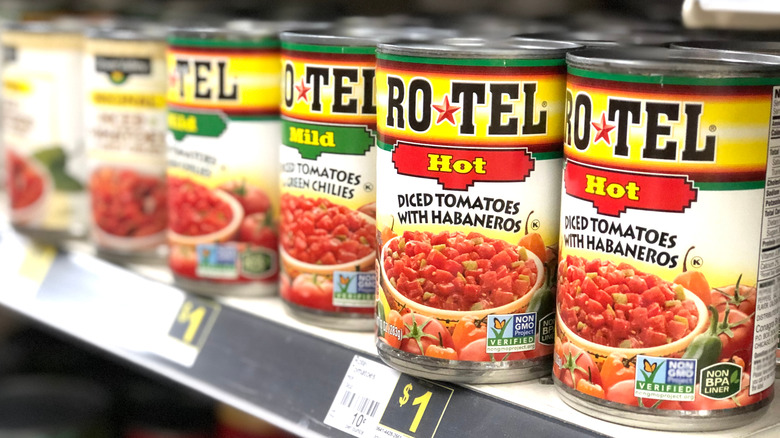Turn A Can Of Rotel Tomatoes Into Cheese Dip With Only 2 Ingredients
No tailgate party in the south, Texas in particular, is complete without a crockpot full of Rotel dip. In case you're unfamiliar with this southern favorite, the cheesy chip dip is essentially a spin on Mexican chile con queso. (Indeed, in the Lone Star State, the word queso is synonymous with Rotel dip). Rotel is the brand name of canned diced tomatoes and green chilies, both quintessential ingredients in many queso recipes.
To make this delicious dip, besides a can of Rotel, all you need is Velveeta and ground beef. Simply brown the meat in a pan, drain, and add the Rotel and Velveeta cheese. Stir on medium heat until the cheese is fully melted. (You can also try using a double boiler to melt Velveeta cheese and avoid burning it.) The mild version of Rotel packs some zest, but if you prefer your queso on the spicy side, grab a can of hot Rotel (made with habaneros instead of green chilies). Consider adding chili powder for an extra kick.
Alter the consistency by adding milk to thin it out or incorporating a surprising ingredient from your medicine cabinet for smoother cheese sauce. Rotel dip is commonly served with tortilla chips but it goes well with crackers and veggies, and it also makes a tasty sauce for tacos and baked potatoes.
Origins of Rotel dip
Chile con queso is largely believed to be a blend of Mexican and Texan culinary influences, also known as Tex-Mex. While the exact origin of queso is debatable, one historical account traces its beginnings to a San Antonio Tex-Mex restaurant opened in 1900 called the Original Mexican Restaurant. In the book "Truly Texas Mexican" (via San Antonio Magazine), author and chef Adán Medrano writes that the restaurant was operated "by Anglos for Anglos," serving Americanized versions of Mexican dishes, including chile con queso. More Tex-Mex restaurants were popping up in the 20th century, finding ways to fast-track indigenous home recipes by using packaged ingredients like chili powder, processed cheese, and eventually Rotel.
In 1943, Texan farmer Carl Roettele started a canning plant in Elsa, Texas and began canning tomatoes and green chiles together, shipping them to cities in Texas. He shortened the name of his zesty canned concoction to Rotel to make it easier to pronounce. By the mid-1950s, Rotel was spreading to other southern states like Oklahoma and Arkansas. Ultimately, its popularity caught on nationwide, even making its way to the White House. First Lady and Texas native Lady Bird Johnson popularized Ro-Tel canned tomatoes when she shared her favorite Texas recipes, including chili she made with Rotel listed as one of the ingredients. Rotel is now available at most chain grocery stores nationwide and continues to be a popular quick, zesty addition to chili, soups, casseroles, and dips.

